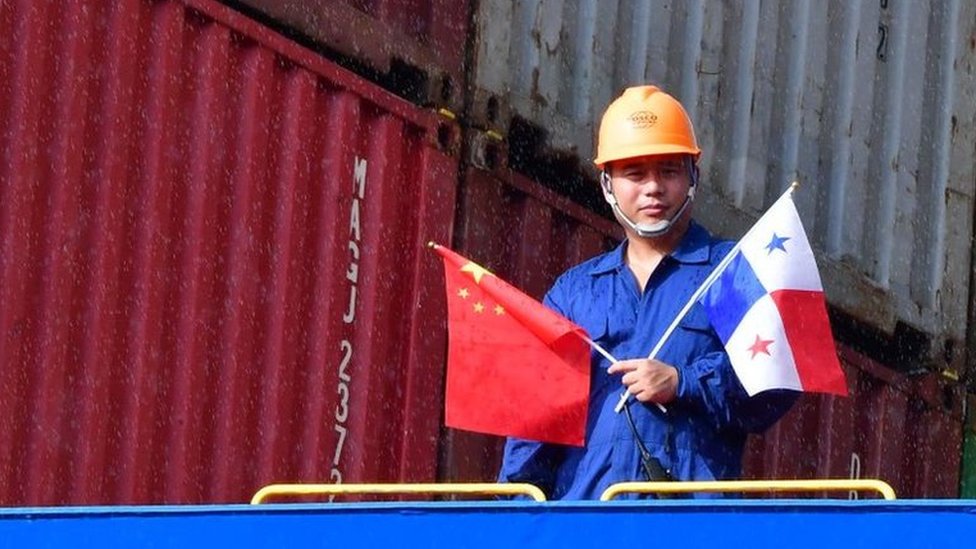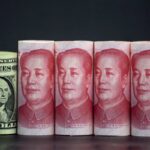Global Courant
The Asian giant’s trade with Latin America has skyrocketed, going from $12 billion in 2000 to $495 billion in 2022, making Beijing South America’s biggest trading partner.
Panama and Uruguay are planning to give a new impetus to their treaties.
On the other side of the scale, the United States has ruled out new economic pacts and the European Union has yet to ratify the free trade agreement with the Mercosur bloc, even after 20 years of negotiations.
So where some advance, others seem to retreat.
Getty Images
The country chaired by Laurentino Cortizo was always one of the staunchest allies of the United States in the region and a key geopolitical node thanks to its Canal.
The interoceanic waterway plays an essential role in world trade, and the activity of foreign countries in the canal zone has been an important factor in the country’s foreign policy.
Around 140 large multinationals have their headquarters in Panama thanks to the incentives they receive and the country’s role as a regional financial and logistics center.
Increase in projects
In May 2022, Cortizo described the US as Panama’s most strategic partner, but noted that China was the second main user of the canal.
In addition, Wei Qiang, Chinese ambassador in Panama, has repeatedly reiterated the special interest in the region in sectors such as energy, mining, natural resources, and trade.
“The canal zone has seen a surge in Chinese infrastructure projects in recent years, and the Panamanian president has pledged to restart long-stalled negotiations with China over a free trade agreement,” explain Emilie Sweigart and Alonso. Velasquez, from Americas Quarterly.
Getty Images In December 2018, a year after Panama changed its recognition of Taiwan, Chinese President Xi Jinping paid an official visit to the country.
Panama’s turn towards China began in the administration of its previous president, Juan Carlos Varela.
In June 2017, the Central American country severed its longstanding diplomatic ties with Taiwan in favor of establishing relations with China.
At the time, the Panamanian government said it recognized that there was “only one China” and considered Taiwan part of it.
The governments of Beijing and Taipei insist that the countries cannot recognize them both.
China views Taiwan as a breakaway province.
From Panama to the rest of Latin America
Since then, explains Euclides Tapia, professor at the School of International Relations of the University of Panama, “China has developed an aggressive investment policy in key places of the Panamanian economy, fundamentally taking advantage of Panama’s geographical position as a node in the system of global trade”.
“It is no coincidence that of the almost 40 Chinese companies established in Panama, half of them have accepted the special regime law to make the country their regional re-export center, from where they send merchandise to the rest of Latin America.”
Tapia talks about the Colon Free Zone, which functions as a logistics center for all kinds of Chinese products, from electrical appliances to clothing, household items and, above all, medicines.
And more recently, China has started manufacturing cars in the area from where it hopes to distribute them to the region.
Getty Images
“The canal is a strategic asset, which China wants to take advantage of to build its own profile in the region. The change of recognition from Panama to Taipei accelerated these efforts,” says Eric Farnsworth, who heads the Washington office of the Council of the Americas.
“But Washington has reacted negatively to China’s growing presence in Panama. More can be done, particularly as Panama wants more resources to address the growing migration flows from South America. So far the tangible results have been limited.”
The position of the United States seems limited to warning of the strategic risks of China’s presence in Panama, says Professor Carlos Guevara Mann, professor of Political Science and director of the master’s program in International Affairs at Florida State University in Panama.
“Beware of Chinese”
“The United States is taking no action to counter that Chinese advance. They complain about the Chinese presence, but beyond that they do nothing,” she says.
“For a while there were several visits from high-ranking US officials and the message they gave was that Panamanians should be careful with China, that the Asian giant promises a lot, but fails to comply or if it does comply, compliance comes with many ties and those ties They are dangerous in the long run. That is the discourse they have had”, adds the professor.
Cortizo told the Financial Times last month that “the speeches are very nice” but that the US should “reaffirm its promises of economic support.”
The arrival of Cortizo to the presidency has stopped some of the projects with China signed by his predecessor, including the construction of a fourth bridge over the Canal, in order to reassess the terms of the agreement.
Getty Images
Panama is trying to navigate between the United States and the People’s Republic of China, trying to get benefits from both and maintain good relations with both, but for Evan Ellis, a Latin American studies researcher at the US Army War College Institute for Strategic Studies In the US, it’s all about “making smart decisions”.
“The United States is concerned and uncomfortable with China’s progress and the impact on its own ability to advance certain objectives in terms of democracy and human rights and in its own relationship with the countries of that region,” he told BBC Mundo in an interview. Ellis, who worked at the State Department during the Trump administration.
Financial and banking services
“But aside from that discomfort, I can say firsthand that while President Biden’s tone to President Trump has certainly changed, no one is telling other countries not to do business with China,” he says.
Ellis says the US argument is that it is better to do business from a transparency perspective, in a framework of the rule of law and a level playing field that allows for good choices about contracts that actually work.
For this expert, the greatest risk of this rapprochement, although limited, is that a future Panamanian government “motivated by the ideology or self-interest of its elites, moves away from transparency and good governance, to use China for the purpose of protect their political autonomy and illicit gains from Washington.”
And it is that Panama has a platform for financial or banking services that is interesting for China, experts say.
Getty Images
These increased ties “give China a privileged position in a strategically important country,” Farnsworth says.
“Beyond the obvious symbolism, a physical presence in Panama allows for greater ties with local authorities, international users of the canal and the promotion of Chinese interests from the migration of Chinese citizens to the murky Colon Free Zone.”
But others think that Panama should use the rivalry of both powers to its advantage.
“Latin America and Panama clearly must take advantage of this moment of competition between the United States and China. We know and are aware that we are debating between the two largest economies in the world,” Venicia Chang Monterrey, a specialist in Human Rights and professor at the School of International Relations at the University of Panama, told BBC Mundo.
But navigating between two waters will not be easy for the country faced with the dilemma of raining investment or angering a former ally.
Now you can receive notifications from BBC Mundo. Download the new version of our app and activate them so you don’t miss out on our best content.








